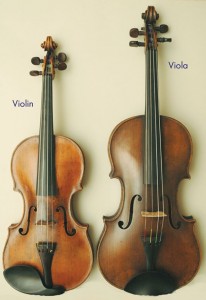Kitty
One of my best girlfriends and someone who regularly de-railed my train of thought and my life in general, was my viola playing friend Kitty. She was a bit of a classical snob, and I totally understand that, ‘cause most classical players work really hard to master the skills necessary to play that type of music and they are in an elite category. Kitty was particularly interested in the ‘Baroque’ style of music and the kind of odd-ball instruments used at that time. Music, of course, is a continually evolving art form, and when folks talk about ‘Baroque’ music they are usually referring to a pretty broad range of styles and techniques that came from Europe during the Renaissance and Baroque periods. ‘Course it’s the musicologists and historians who have named them that—they didn’t know they were Baroque musicians, they were just doing what musicians do. The so-called Renaissance period started in the 1400’s and the Baroque era lasted for 150 years or so, from 1580 to 1730.
During this time, things were getting better for the ordinary folks—there was less political unrest, relative prosperity, musical education was available in schools and churches, and trade and colonization was opening up minds to new artistic endeavors. Then along came the Guttenberg Press, which probably changed things for those people as much as the computer and cell phones have changed our lives. Written music became standardized, and everyone could understand and communicate their ideas to others because they now all understood the symbols being used. Composers could write out separate and precise parts for the instruments they wanted to use. Music theory was discussed and the average guy had access to the genius of the likes of Bach and Handel. Lyrics and poems were no longer recited for the amusement of rich kings, or only to praise a specific religious doctrine, though to this day, spirituality and the interpretation of life are still worthy sources of inspiration for musicians and composers. Music became a vehicle for personal expression. This was a time of profound achievements and creativity—great minds were tackling big cosmic questions about the universe, evolution, science and the meaning of life. Great musicians were being set free and were encouraged to communicate the power of music. Shoot, they invented Opera—the only time you’ll see a guy get stabbed, and instead of bleeding and dying, he sings!
As soon as a musician begins to play with other, real live people, then they have to think about and define their job and their contribution and how they fit into the ensemble mind set. Now maybe the composer will delegate the instrumentation and will write out the notes he wants played, but the musicians need to become involved in understanding the writer’s intent and helping to achieve it. It doesn’t matter if you are the bass player for a KISS tribute band or the trumpet player in the symphony—first you learn and hone the skills you need as an instrumentalist or writer or vocalist, then you evaluate how you fit into the vision of the composer or band leader. Then you hopefully learn good taste and restraint and do your job as part of the bigger picture. Doesn’t hurt if you can throw out a few scorching hot solos….
Getting back to the viola and Kitty and whatever— the viola de gamba was designed to be a kind of middle range drone and rhythmic instrument, often playing a harmony to the main melodic things going on. During this time new instruments were being invented to satisfy the ideas of composers—like the trombone, oboe or timpani drums. The viola kind of got shoved into the background musically by the development of the violin, which was louder, flashier, and not as difficult to physically handle as the viola. Kitty and I used to laugh about the inevitable question people ask, “What’s the difference between a violin and a viola?” Well, being the ruder and more sarcastic one, I would answer “The viola burns longer.” Which is true. A viola is basically made just like a violin, only it is bigger. The body length of a modern violin is around 35 cm’s and a viola is from 40 to 43 cm’s. The viola is kind of like the quiet, middle child who is ignored by his parents and overshadowed by his more active and successful siblings. But a good viola player doesn’t give a darn about that, because they know that the beautiful, dark and rich sounds they produce have meaning and are just as important as anyone else in that big picture thing.
Another difference between a viola and a violin is the ‘clef’ that their written music is played in. Ok—stay with me here. Picture the 5 parallel staff lines that music is written on—if you put a note on each space and each line, they represent the white keys on a keyboard. The higher pitched instruments and the lower pitched instruments can’t be using the same notes, so there are symbols at the beginning of the tablature to basically define the ‘clef’ or pitch, so we can all read the parts using the same 5 lines. Most high pitched instruments (like violins, flutes, trumpets, mandolins, banjos and guitars) are in the treble (or G) clef. These would be the keys to the right of middle C on a piano. The low guys are in the bass (or F) clef, and the viola kind of straddles both sides of middle C, putting it in the alto (or C) clef.
There’s always been a bit of rivalry between the folks who play violins and violas—viola players think us violinists are swaggering exhibitionists and we think they are dreary mopes. There are lots of snotty jokes about viola players, partially because they are outnumbered like 4 to 1. How do you keep your violin from getting stolen? Put it in a viola case…. Or why do so many people take an instant dislike to the viola? It saves time…. Or what’s the difference between a seamstress and a viola player? The seamstress tucks up the frills…. (Yeah, I know, that’s kind of obscure.) Or how do you get a violin to sound like a viola? Either sit in the back and don’t play, or play in the low register with a lot of wrong notes…. Or if you’re lost in a desert, what do you aim for? A good viola player, a bad viola player, or an oasis? The bad viola player—the other two are only figments of your imagination.
 Well, my friend Kitty would hire me occasionally (when gigs were slow and the snow was falling) to do simple woodworking at her warm and cosy and music-filled shop in Nederland, Colorado, where she made beautiful harpsichords. That is a soft, lovely sounding wooden keyboard instrument from the ‘Baroque’ era—her business was called “Gopher Baroque”. She traded in the cold and windy weather and moved to a beach in Belize, much as I have done. We had a long and wonderful friendship, even if she was a viola player. RIP.
Well, my friend Kitty would hire me occasionally (when gigs were slow and the snow was falling) to do simple woodworking at her warm and cosy and music-filled shop in Nederland, Colorado, where she made beautiful harpsichords. That is a soft, lovely sounding wooden keyboard instrument from the ‘Baroque’ era—her business was called “Gopher Baroque”. She traded in the cold and windy weather and moved to a beach in Belize, much as I have done. We had a long and wonderful friendship, even if she was a viola player. RIP.
Come on out some night and listen to Ben Jammin’ and the Howlers—we play most every Friday night at the beautiful and spacious Roca Verde bar and restaurant down south in Dominical, starting at 7:30 pm. I play a 5 string violin, which means I am greedy and have the best of both worlds—my violins extra low string being the high C string of a viola. There are a few venues in Dominical and the Quepos area that hire musicians—Hawg ‘N’ Bill in Manuel Antonio consistently has live music, as does Dos Locos and Wacky Wanda’s downtown. There are special shows at Patron’s, the Rum Bar and Maracatu in Dominical. Support the clubs and venues that support live musicians!
A table, a chair, a bowl of fruit and a violin; what more does a man need? Albert Einstein
The viola is commonly (with rare exceptions) played by infirm violinists, or by decrepit players of wind instruments who happen to have been acquainted with a stringed instrument once upon a time. Richard Wagner, composer, 1869
It takes generosity to discover the whole through others. If you realize you are only a violin, you can open yourself up to the world by playing your role in the concert. Jacques Yves Cousteau


